Bonnie Netherton: Traveling a Winding Path to Women’s Community
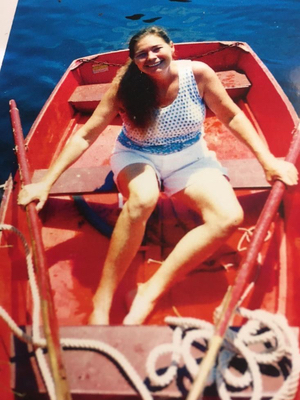
Interviewed by Rose Norman at Sugarloaf Women’s Village November 4-6, 2013; July 20, 2017; and by phone on June 24, 2022
Since 2006, Bonnie Netherton has been a permanent resident of Sugarloaf Women’s Village, a women’s community land trust on Sugarloaf Key, Florida, near Key West. During those years, she has served on the land trust board, built the website, handled guest reservations, assisted guests, and worked hard on improving the property. In this interview, she describes her adventurous journey to and life at Sugarloaf.
Bonnie Netherton: I was born in New York City, to parents who both grew up in New York City. My dad joined the Coast Guard after being in the Merchant Marines during the war. Being a Coast Guard officer meant that my family moved every year or two. That’s how my life was as a child, and as an adult I just continued in that way. I moved a lot, went to a lot of different places, did a lot of different things, had adventures! I had a lot of adventures. (Laughter) The very best years of my life were the years that I lived on the water, on the boat. I think of those years as the best, the best I ever lived. It suited me so well! It really suited me to be on the water every day.
Rose Norman: I know you were moving every two years. Is there a pattern to it apart from the moving? Did you go to college?
BN: I did not. No.
RN: What did you do instead?
BN: Well, I moved to Chicago, Illinois, and I lived there for a few years. I married there, married a man, and we moved because of his work. We lived in Chicago and in New Orleans, Louisiana; San Francisco, California; and Atlanta, Georgia. Atlanta was where I realized that I was a lesbian.
Biographical Note
Bonnie Netherton (born Gail Frances Richter) was born in 1945 in New York City, New York, where both of her parents grew up. Her father was a Coast Guard officer, and the family moved every two years or so, always near the ocean. That pattern of frequent moves characterized her life until she moved to Sugarloaf Women’s Village, Sugarloaf Key, Florida, in 2006.
Becoming Politicized
In San Francisco in 1969, I joined La Leche League, and that politicized me because they were so willing to disregard their doctors’ opinions and orders and do it their own way. Before that, I didn’t have the courage to go against the doctors. La Leche was all about natural childbirth and breastfeeding, and provided regular meetings and a wonderful book, The Womanly Art of Breastfeeding. Like AA or other groups of that kind, there was always someone available to you when you needed help if you were having problems. First-time mothers can have really hard problems with breastfeeding. At that time, doctors had no training in breastfeeding, none at all. The obstetrician was in charge of the woman’s body, and the pediatrician in charge of the baby, and neither one knew anything about breast feeding. I did have a great pediatrician in San Francisco. When I went back for the first visit with my son, he had lost weight. Most doctors would say I had to put him on a formula because of that. But he had me sit down and nurse my son right in the office. He weighed him before and after. He had gained four ounces, which was just what he should have done, so he told me the baby was fine and I was doing it just right. La Leche called it “the womanly art of breastfeeding,” and it was an art that was being lost because of formulas.
When my second baby was born, we were in Southern Illinois, and things were different. During those years, I was in my own little world, focused on having children. I never worked outside the home once I had children, mot until I left my husband.
Coming Out
Coming out and leaving my husband came at the same time. My experience with La Leche got me ready for consciousness-raising. When we moved to Atlanta, I joined a CR group. I fell in love with both of the lesbians in my CR group. I had always been attracted to women, but I didn’t know what to do about it. It wasn’t until I found a couple of lesbians that I had some idea what to do about it. It happened after one of our CR meetings, held at my house. I walked one of them out to her car and told her how I was feeling. We kissed, and oh, my god, it was a huge thing. It became even huger because my husband walked out the door and saw us. We immediately spent hours talking about who was going to leave and who was going to stay. I was very happy and excited about my new life.
Finding Work in Atlanta
When I first left my husband and children, I went back to work for Arthur Anderson, whom I had worked for in Chicago, New Orleans, and San Francisco, so I went back to work for them in Atlanta. It really opened my eyes to the business world and politics. In Atlanta, I was learning to program; they were putting all of their records on the computer. I was going through zillions of records and learning things I didn’t know, like all the lobbyists these companies had, and how they were the ones making the laws, not Congress members. It was really upsetting to me. I loved programming, I loved working with computers. It was a new field and exciting to me. But I knew I couldn’t work for that kind of firm, so big and so prestigious, and still so rotten. It actually made me sick. I needed to stop doing that work and find something else. That was when I got my real estate license. My mother had been a realtor for a little while, and I knew I could do it as cleanly as possible.
Red Dyke Theatre
RN: In Atlanta, you joined Red Dyke Theatre?
BN: Right. It was right at the same time that ALFA was forming. [ALFA is the Atlanta Lesbian Feminist Alliance. Stories about ALFA appear in Sinister Wisdom volumes 93, 109, and 124, and there is a story about Red Dyke Theatre in volume 104.]
RN: ALFA formed in 1972. (See Red Dyke Theatre interview.)
BN: Well, I had my first interactions with ALFA and Red Dyke Theatre in 1974.
RN: Our timeline says the first performance of Red Dyke Theatre was December 31, 1974 [this is from ALFA archives at Duke].
BN: Yes, and I wasn’t a member yet.
RN: Now Red Dyke Theatre was political theatre. Was it mostly feminist, all feminist?
BN: It was mostly feminist. One skit that Jaen [sic] Black and I did was about lesbian relationships, a comedy. I played a character called Bonnie Blameless. She was a customer, and I was selling emotional insurance. It was a spoof on lesbian relationships, but sort of serious.
RN: Where did you perform?
BN: One show was at the Great Southeast Lesbian Conference in Atlanta [May 24-26, 1975; ALFA organized it and Red Dyke Theatre performed on the Saturday night]. One show was at a gay conference. These were done in big theatres. There was one done at Sweet Gum Head, a gay bar that had a really nice stage. They had drag shows there that were very well done. I think that’s where we showed the film.
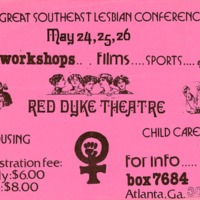
I remember something really wonderful that happened at the Great Southeast Lesbian Conference. At that time there was a divide among lesbians, between the ones into butch-femme and the ones who were androgynous. The Tower Lounge, a lesbian bar that had been around for a long time, was owned by two women who were butch-femme. Most of their clientele were butch-femme. They wanted to sponsor a softball team for the Atlanta league [the same one that the ALFA Omegas were in]. They also wanted to talk about butch-femme and how they saw it and the divide. They did a workshop at the Great Southeast Lesbian Workshop, in the ALFA House, I think. It was very, very good, very touching, and it really healed that division in the Atlanta community. ALFA dykes started going to the Tower Lounge and supporting them. And they supported ALFA and sponsored this softball team that I played on, the Tower Hotshots.
Red Dyke Theatre was a pretty intense group. Some of the women in it were really great performers—and I don’t include myself in that group. Certainly, Mickey [Alberts] and [Frances] Pici were really wonderful performers. We did skits. It was like a variety show, singing and dancing and skits. Mickey would choreograph us for big dance numbers we were all in. Some of the skits were really hilarious. Deborah Gray was another person that was involved. She and I did a film, filmed by a couple of Atlanta women who were film-makers (or trying to be film-makers). We filmed it three times, first in 8 mm, then 16 mm, then 35 mm film.
RN: Who wrote the script?
BN: It was silent. There was no script. It was just three scenes, and the scenes were shown at different times in the bigger show.
RN: So you showed the film during a Red Dyke Theatre variety show?
BN: Yes, but I don’t think anybody else would call it a variety show. It’s just my descriptive term. I was inspired to make this film by the book Emmanuelle. I don’t remember what about it inspired me. It was filmed mainly in silhouette. You could see who we were but — I don’t remember exactly how we filmed it.
RN: Behind a scrim?
BN: Not really. I had a big lace shawl, and it was partly behind that. Anyway, it was just three short scenes, and it brought the house down. We weren’t used to seeing anything like that in 1974, 1975. It was really an exciting thing to do. Deborah Gray and I did the film. The filmmakers were Winona Halloway and Marcia Still. They kept the film, though I paid for it. Because they were film-makers, I thought it was best that they have the film.
RN: What were the three scenes?
BN: They were just erotic movements. We were both naked, and we were kind of making love.
RN: Was it like dance?
BN: I wouldn’t say it was dance, but it was choreographed. Maybe a little like dance.
RN: There’s something called contact improvisation.
BN: We weren’t improvising. The reason we filmed it in those three different modes was because we wanted to get it right. We did the same thing in all three. Maybe we improved it.
Losing Custody of Her Children
RN: You have two grown sons? Where are they now?
BN: Atlanta. One, the youngest, died a few years ago; he died of a heart attack. The oldest is still in Atlanta. I never did spend very much time with them after I was divorced. When they were young, I did. They were only two and four when I left. I stayed in Atlanta because of them. I stayed in Atlanta for seven years. At that time that was the longest I had ever lived anywhere. But then my lover…
RN: Did you stay there because of the children?
BN: Yes, to be near them. I expected when I left that my husband and I would have joint custody of them. But that didn’t happen. He got the ‘hate lesbians’ fever and took me to court in a bad way. I had a wonderful lawyer, Margie Pitts Hames. She fought and won the abortion issue in Georgia. She was a feminist lawyer, and her advice for me was to never show my face in a courtroom if I wanted to have anything at all to do with my children.
RN: Whoa! When you say you didn’t get joint custody, does that mean you lost custody, or did you have some kind of visitation rights?
BN: I had some visitation rights. I expected joint custody because I thought of us as a modern young couple, you know, and that’s what people were doing in those days if they cared for each other and the children. So that was what I expected, but it was not what happened. My visitation rights were very limited The divorce paperwork even stated that if I harmed those children in any way, physically or psychologically, that the court could say I couldn’t see them anymore. It was pretty horrendous. My attorney didn’t think I had any leg to stand on. She just thought I needed to not fight it at all or there would be worse consequences. She actually had pretty much the exact same situation with another lesbian I knew, so I had to take her at her word. But my kids didn’t grow up spending much time with me when I still lived in Atlanta.
What really changed it all for me was that my lover, Patti, was killed from catastrophic injuries in an automobile accident. After that, Pici [Frances Pici of Red Dyke Theatre] and Harriett [Green] invited me to live with them, and I did. We were good friends. I moved in with them, needing someone to be close to, needing that kind of comfort at the time. After a few months living with Pici and Harriett, which was a wonderful time, I decided I needed to be near the ocean; that was always my healing place. As a child, we always lived near the ocean because my dad was a Coast Guard officer. The ocean was, for me, really my place.
I was hurting pretty much after Patti died, so I went to St. Simon’s Island. I decided I just really had to go and be by the ocean. I rented a house on St. Simon’s for a couple of months. Pici, Harriett, and Star [Woodward] came with me. Mickey [Alberts] and her lover Julie joined us after a while. We were all there in this great house right on the beach. We’d only been there less than two weeks when I got word that my father had died of a heart attack. Three days later my mother died of an asthma attack. My parents were only sixty and sixty-one.
RN: (Deep sigh)
BN: Yeah. So anyway, that year was amazing. I learned a lot about myself, a lot about grieving and death, and it was something else. It was a pretty amazing year of intense love and friendship, and deep, transformational spiritual growth.
RN: Would it be 1980 by now?
BN: Yes. That’s exactly when it was. 1980.
RN: How did you get down to Key West in 1983 from St. Simon’s?
BN: I decided I wasn’t going to go back to land-locked Atlanta. Star and I stayed in St. Simon’s for about three years. I had gone to Key West on a lark sometime in the ‘70s and thought it was a great place. I think I went there in the ‘70s, maybe ’76. Then Harriett and I went for a week to celebrate the sale of a house we had renovated together for the purpose of reselling. I decided I was going to move to Key West. I loved beautiful St. Simon’s but the winters were bitter and I couldn’t enjoy the beach in the winter. It was hard to be on the ocean and not be able to walk on the beach because it was so bitter cold. Maybe those were unusually cold years, I don’t know. So that’s what made me move to Key West.
I went to Pagoda first for a two-week visit. While I was at Pagoda, Barbara Lieu and Lavender Lieu (Lavender later became Valentine), gave me an introduction to Barbara Deming. [Deming was an internationally known peace activist. The Pagoda was a lesbian intentional community and cultural center on the beach in St. Augustine, Florida. Pagoda women had a strong connection to women at Sugarloaf, which was not yet Sugarloaf Women’s Village at that time. Deming then owned the Sugarloaf property.]
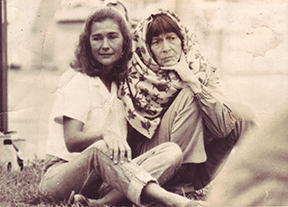
RN: Did they go down there with you?
BN: No, no they didn’t. I don’t know exactly the story of how they met Barbara, but she was very attached to Lavender and to Morgana [MacVicar], who was administrator of the Barbara Deming Money for Women Fund, benefitting women artists.
RN: Now it’s 1983 and you have moved to Key West. So you only knew Barbara Deming about a year. That’s a great picture of you with her.
BN: Right! I’m so glad—I love that picture. I’m very attached to it! I don’t know who took it, might have been Rainbow [Williams]. I know where we were, and what was happening, but I don’t know who took the photograph. It was a gathering in Key West at the end of the Peace Walk that some women from Gainesville had organized. Gainesville women and Rainbow were there, though Rainbow was not a Gainesville woman; she was a Pagoda woman. I didn’t see the photograph, probably, for a couple of years. [We attempted to identify the photographer and think it was Julia Driskell, who took many Peace Walk photographs that were later published in Rainbow’s newsletter Changes.]
RN: OK, let’s go back. We’re in 1983, you’re living in Key West, and then you worked at the bar there, or…when you moved to Key West, is that when you worked in that bar?
BN: No, it was much later, actually. Well, not much later, but I worked at Pearl’s, which was a women-only hotel. It was a really nice place, probably the best lesbian hotel ever. I think I worked there for two years. I wasn’t still working there when my boat got wrecked, but I was working there very shortly before that.
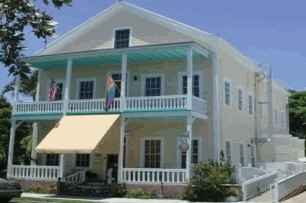
RN: So that would have been the early 2000’s, like ’02, ’03, ’04, something like that. So what did you do, because somewhere in here I know you lived in Gainesville, didn’t you, and got a real estate license or something?
BN: Right. I had a real estate license in Georgia and in Florida. I was selling real estate in Atlanta and later in Gainesville. I enjoyed that—that was a good career for me. I really like houses, I like homes, and I really enjoyed finding just the right home for someone. I worked on this almost exclusively with lesbians. It was fun because I would find usually first-time homebuyers so I could get really good special mortgage deals for them. There were good programs in Gainesville, and in Atlanta, actually, for first-time homebuyers.
RN: So you were in Atlanta seven years. You came out there. Then you went to St. Simon’s, then you went to Key West. But you must have moved to Gainesville sometime between moving to Key West and the…
BN: Yes, there were other things happening there. Let’s see, during that time I went to Mexico in a school bus and traveled around Mexico and Guatemala for almost two years. That was another great adventure I had.
RN: Was that when you were with Nancy? [Nancy Anderson is now known as Trey.]
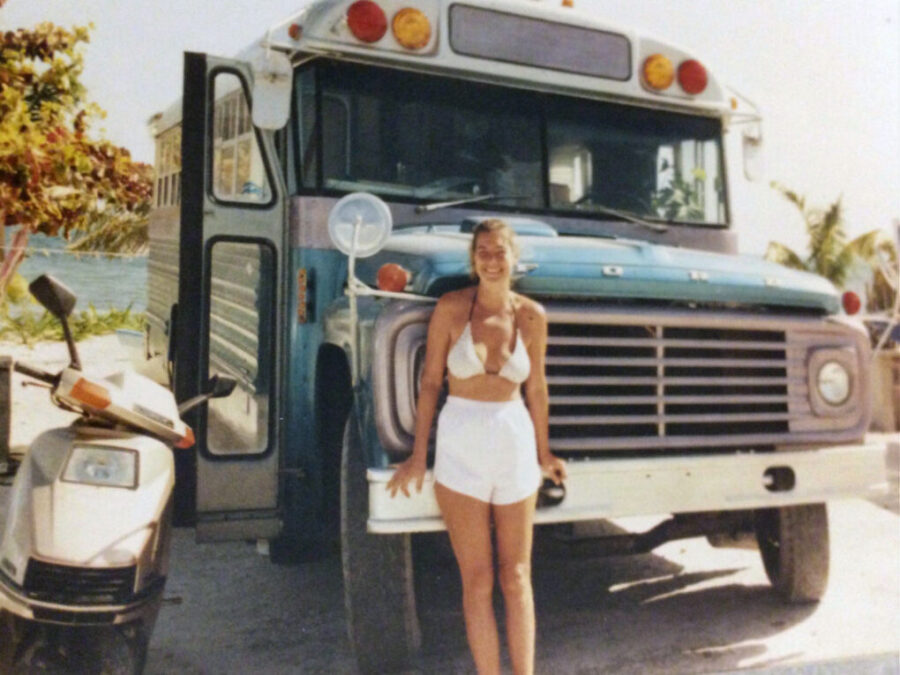
BN: No, I met her after that. I went to Gainesville because I had friends there. Star [Woodward] was living there. After I came back from Mexico, I went to Gainesville.
RN: Ok. So we’ve got Key West, and you went from Key West to Mexico and Guatemala?
BN: Yeah, I bought the bus in Key West and drove it to Mexico. I had a girlfriend then, a really special woman, who went with me. Her name was Skyler, Skyler Maxwell.
RN: How did you do that two years on the road? Were you selling things along the way or what?
BN: No. Because my parents had died, I had a little income from their estate, and it was enough to do that.
How Bonnie Came to Sugarloaf (in 1983)
[From 1983 on Bonnie visited Sugarloaf off and on and lived here for a few months at a time, usually house-sitting, as when Barbara Deming and her life partner Jane Verlaine went to New York for Barbara’s cancer treatment.]BN: In 1983, I was moving to Key West from St. Simon’s Island, and I had my car full of my belongings and my wind surfer on the roof. I had stored most of my stuff. I stopped at Pagoda [in St. Augustine] on the way, and spent a few days there. Barbara Lieu and Lavender Lieu told me I had to meet Barbara Deming. They called Barbara and gave me an introduction to her and let her know that I’d be coming. When I got here, Barbara came right up to my car, looked in the window, and said “I believe the Goddess has sent you to us.” I wasn’t even out of my car yet.
[Bonnie became very close to Barbara, and Barbara wanted her to become a permanent resident and live at the new house they had just bought, what is now the community house. But Bonnie wanted to live in Key West, and wasn’t much interested in living in community, though she came back to Sugarloaf to visit many times.]BN: I left here [Sugarloaf] not long after Barbara’s death [in 1984]. I was not feeling comfortable. There was a lot of bickering, and people kind of jockeying for position, and I wasn’t grieving Barbara the way other people were. I really was accepting of her death. I needed not to be there, and I didn’t intend to live there anyway, back then.
RN: You also lived in Ft. Lauderdale, Florida; that was when you ran the Mermaid Inn.
BN: That’s right, yeah.
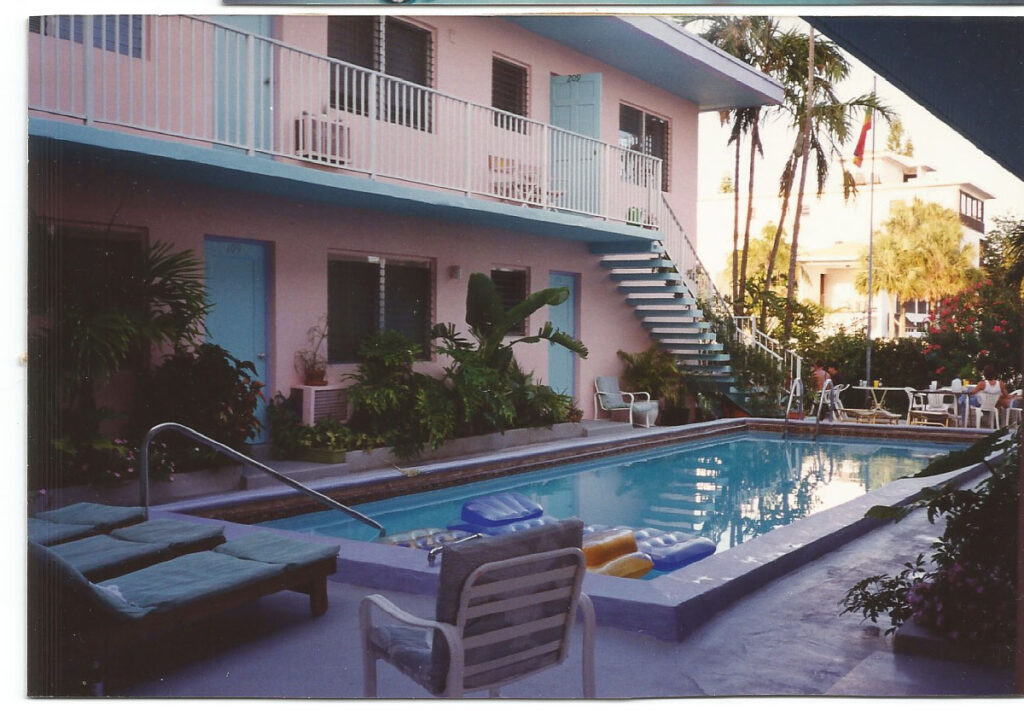
RN: When was that?
BN: That was from maybe ’89 to ’93.
[Read the story of the Mermaid Inn in Sinister Wisdom volume 109.]Bonnie’s Lucid Dream Come True

I dreamed that a big group of us were gathered on a dock or pier, celebrating the fact that a boat was coming in. A little girl, about six years old, came up to me. She had a string of plumeria flowers, not a lei that she could put around my neck, but something she put around my wrist. It hung down to the dock. I looked at it and saw my hand, and it became lucid, so I knew that I was dreaming. Around sunset I looked at the water and thought, “I don’t know if I want to jump in that water to breathe underwater. It’s gonna be too cold. I’ll just fly.” (laughter) So I flew off the pier and out over the water, looking for the boat that was supposed to arrive. I saw a red Chinese junk with red sails. I was pretty high up, and I could see someone on deck with long brown hair flying all around. As I got closer I realized it was me. I thought to myself, “Ah, I can be in two places at once!” Then I was filled with a tremendous longing to be there, to be that me, and as I felt that longing I started losing control of the dream.
About three months later, I found the boat. I had been hunting for a Chinese junk for years, years! I had tried to buy two other junks that I found in other places. This time I saw an ad for the boat in a sailing magazine. I drove up to Massachusetts to see it. When I saw it, I knew it was that boat that I had dreamed. If I hadn’t had that dream, I never would have bought that boat because it was in such bad condition. It took a lot of work to bring it up to standards, to make it seaworthy.
Those were the best years of my life [the years living on the boat]. I loved living on the water, I was happy every day! I felt like I got up happy every morning and went to bed happy every night during those years. I just loved it.
[From 1998 until 2005, Bonnie lived on Ming Meng (Lucid Dream, or Brilliant Dream), moored a half mile off Key West on the Atlantic side. When Blue Lunden was dying in summer 1999, Bonnie stored the boat on Cudjoe Key while staying at Sugarloaf to be with Blue. Then she moved back to the boat. Hurricane Wilma came in 2005, not long after Katrina, and the two storm surges were devastating to the Florida Keys.]RN: That was off the coast of Key West, and it was from, what, 1990—
BN: From 1998 to 2005.
RN: OK. That was Wilma, the hurricane.
BN: Yeah, Wilma in October of 2005. It was kind of a late hurricane.
RN: The hurricane season was almost over. That was the hurricane that pretty much wiped out the Sugarloaf community house, too, or what was it? Not the hurricane itself but the—what do they call it? The wave that comes after? It was the flooding.
BN: Storm surge. In 2005, Hurricane Wilma had a huge storm surge after it.
Hurricane Wilma changed the face of the Keys in big ways. The flooding was really terrible. The storm was not that bad, but the storm surge was terrific. There were two of them, the first from the Atlantic side, the second, two hours later, came from the Gulf side. At Sugarloaf, about five feet of water came through. This house [the community house, where the interview took place] took five feet of water. The other houses are higher and got less damage.
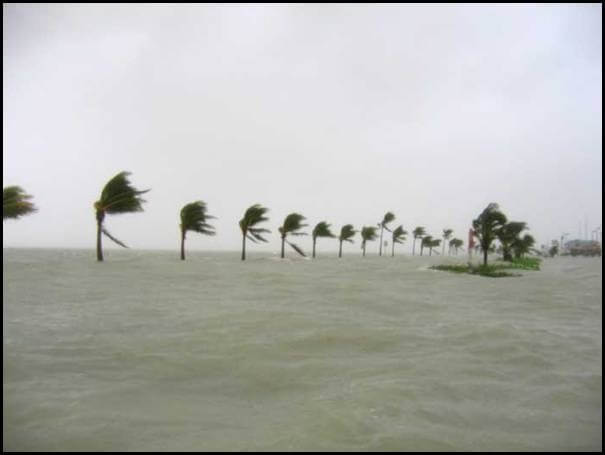
RN: Where did you stay during the storm?
BN: With a friend in Key West who lived on White Street, near the White Street pier.
RN: Is that in the old part of Key West, the part that wasn’t flooded?
BN: White St. is sort of between old town and new town. It did flood, but not so much. When the storm abated, I walked down to the beach in the morning. As I was walking back, the first storm surge arrived, so on my way back I was walking in knee-deep water. The second storm surge came a couple of hours later, and swept my scooter away. I had a big scooter that I could ride on the highway.
They say that it was a particular combination of astronomical events and tides that caused that [the two storm surges], and that, hopefully, things would not come together that way again. It had to do with the stars and the moon and how long and how far the wind traveled across the water. A lot of different things. The surges from Katrina and then Wilma [both in 2005] caused NOAA to begin keeping records and projecting storm surge. Now during hurricane season, you can look on the NOAA site and see what the storm surge prediction is. But that wasn’t the case then. They’re still working on that. I don’t think they’re really very good at it, but they’re getting better, I suppose.
RN: You were close to fifty during those years when you lived on the boat? About fifty years old?
BN: Yes, I was in my fifties. [Age 53-60]
Home to Sugarloaf (2006)
RN: How long have you been a permanent resident of Sugarloaf Women’s Village?
BN: I’ve been here since 2006. I had a year in Key West between Hurricane Wilma and Sugarloaf. During that year, Sugarloaf had been pretty devastated by that hurricane, too, and I’ve heard that five feet of salt water passed over Sugarloaf, so it did a lot of damage.
The community house was really wiped out by that. The other houses, Barbara and Jane’s house where Sandy [Hagan] was living, had damage, and all the walls and some of the flooring had to be replaced in that house. The land was devastated. I mean, you can’t have that much saltwater without causing a lot of damage. There were old, old mangoes and all kinds of fruit trees growing here that were lost. You wouldn’t believe the mangoes. I have a photograph of Blue and Sandy with a wheelbarrow mounded up with mangoes. The mangoes were unbelievable! There was everything from star fruit to lychees to avocados and mangoes. One fruit tree that survived it is the sapodilla. Two of them still here. Someone just brought me a sapodilla from one of the trees just yesterday. It’s a wonderful fruit, if you’ve never had it. It tastes like pears sprinkled with brown sugar.
My boat was swept into big trees alongside the highway and it ended up that I was unable to save it. I lived in Key West for a year after that. Women were coming to Sugarloaf to help, or sending supplies, and money, and tools, whatever they could. Habitat for Humanity got involved, sending a crew of women carpenters and a male electrician. Xylena did a lot of work here. She and Joanna Murray, an electrician, rewired this house [the community house], along with Joanne, another electrician.
Still, at the end of a year, there was so much left to be done here. The land itself had not recovered at all. There was nothing green here. No grass. No leaves on a lot of the trees. It was all gray and brown. There was a FEMA trailer in the front yard of Sandy’s house [where Barbara Deming had lived]. They had given that to Sandy to live in while her house was being redone. You can still see it on Google Maps. Sandy had breast cancer at the time.
[Eight months after Wilma] I had an accident on my scooter that seriously injured my foot. I was laid up for a few months. When I could get around again I couldn’t walk on hard surfaces very much. I started coming up here and working on the land, because I was anxious to be active and I could walk here. I planted things. I rented a big backhoe and, with Tezza and Sylvie, spread five big mulch piles around the entire property. There was a trailer park in Key West that was going to be bulldozed, so I went there and dug up banana trees and other shrubs to plant here. It was very satisfying. I would spend 2-3 days a week here working like that and watching the place get a little better, and a little better.Before I moved here, I decided I could tackle re-doing a lot of the community house. We wanted to have our board meetings here. Sylvie and I put up the interior walls. Everything was built so that if it flooded again like that, the walls would not have to be replaced. The interior walls are Hardie board [fiber cement siding]. All the electrical outlets were moved up about 4 feet off the ground (hopefully, 5-foot floods will never happen again). The plumbing all had to be redone. The kitchen had been torn out. Only the top cabinets in the kitchen could be saved. This kitchen is different from how it was before the storm, but I think this may be how it was in the original building. I found the lower cabinets on the street in Key West (probably a remodeling job), and I refinished them and brought them up here. Some other women added the open shelves on the top and the bottom.
Working on the land and the community house helped me to fall in love with it again and to want to give more. There really wasn’t a residence space available for me to move into, so I lived in the [guest] cottage for three months. We all knew Sandy was dying. After she died, I moved into her house. I moved here in October 2006, one year after Wilma, living in the guest cottage until January. Sandy died in October or November, but I didn’t move into her house right away, out of respect for women who might want to spend time there and think about Sandy. That house wasn’t totally finished then. There was no wall between the bedroom and living room, I think the cabinet doors had not been put back on yet. Sandy had done a lot of work on the house in the year before she died. Other people had, too, but she organized it all. She was very good at carpentry, and did things she’d always wanted to have done in that house. I was treasurer of Sugarloaf at that time, and I kind of raised my eyebrows at some of the things she was doing, but I ended up benefiting from it all. She lived there about twelve years.
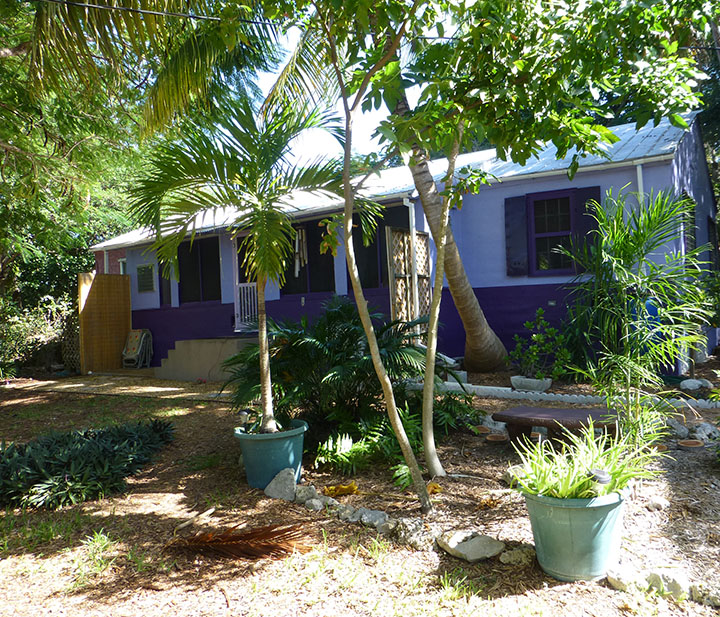
Before Wilma, Sandy had made that house much nicer than when Barbara and Jane lived there, particularly the kitchen. They cooked and entertained from the most horrendous little kitchen. I don’t know how they brought the beautiful things out of that kitchen that they did.
RN: I know that you moved around so much you don’t identify regionally, but do you think of yourself as a Southerner? Your parents are New Yorkers, so…
BN: (Laughter) No, I don’t think of myself as any of those things, really. Sometimes people think I’m a Southerner. I must have some Southern accent? I’m not aware of it, really, but…
RN: I don’t hear a regional accent.
BN: I don’t identify as a New Yorker either, not at all, because I only lived in New York when I was very little. But my grandparents were there, both sets of grandparents were there, so New York is where we went when we went home for holidays.
RN: What part of New York did they live in?
BN: My one grandmother, my father’s parents, lived in East Elmhurst, which is right near La Guardia Airport. My other grandparents lived in Manhattan, up past the Cloisters. It’s called Washington Heights.
RN: Is there anything that we haven’t covered that you would like to add?
Family Mysteries
BN: I was lucky to grow up in a home where the parents really, really loved each other, and it showed. My parents were both only children, and I’ve wondered if that contributed to their appreciation and affection for each other. Having no aunts, uncles, or cousins probably made it easier to keep the secrets of my grandparents. There were mysteries on both sides of my family. My mother’s side and my father’s side both had these mysteries that I didn’t know anything about. On my mother’s side, I knew two great aunts, one of whom I suspect was her actual mother (my great aunt, Eileen Early, who had no children of her own). There was also a childless great aunt on my father’s side, Aunt Dottie, who never lived nearby, and we rarely saw. She was still alive when my parents died, in her eighties, living alone in her little house, so I made a short trip to St. Petersburg, FL, to tell her of their deaths. She had been very fond of my father as a child and a young man, and I just couldn’t give her that news over the phone or in a letter. I was glad I went to see her.
On my father’s side, the mystery was that his family was Jewish. I didn’t know my father was Jewish until after his death. It’s too bad I hadn’t yet learned that my father was Jewish when I visited Aunt Dottie. I wish I could have talked with her about that. Like my grandmother, her sister, she was born in Latvia and came to the USA as a child. If anyone had suggested to me that my father was Jewish, I probably would have been able to figure it out, because there were a lot of clues; of course, there were. And they were things like—
RN: Your family! You were visiting your grandparents and they aren’t Jewish either, I mean they don’t tell you they’re Jewish, you can’t tell?
BN: No, they didn’t. They were not religious. I was just writing something about my grandmother. I talked with my grandmother, my grandfather not so much. My grandmother wouldn’t talk about her past. She grew up in Latvia, and her family came to America sometime before the First World War, I think. I know that there were already pogroms going on in Latvia and other countries at that time. My grandmother would refuse when I would ask her to tell me about her childhood or about Latvia. She said that she had seen such terrible things in Europe that she didn’t believe there was a God, she didn’t think there could possibly be a God. That was her response when I asked her about her religious beliefs. She didn’t believe there could possibly be a God. She was a mystery to me and still is. She is still a mystery!
Right now, I’m reading a book about Key West Jews in early Key West. I also just finished a book, it wasn’t very well-written, but it’s a book about Latvia and about Jews in Latvia around the time of the Second World War. Things were different then, but not much, really.
RN: Where is Latvia? I can’t picture it. Is it a Baltic—
BN: It’s a Baltic state. There’s Latvia, Lithuania and Estonia. All three are on the Baltic Sea, bordered by Russia and Belarus. Russia and Germany, over many, many years, fought over these countries, especially Latvia, for some reason, so they were either ruled by the Russians or they were ruled by the Germans. It went back and forth over the years.
RN: Wow! So how did it come up when your father died? I mean, how did you find out?
BN: I think it was on his birth certificate. I might be wrong, but I’m thinking that’s what it was. He was born in Philadelphia, Pennsylvania.
RN: Hmm. What year was he born?
BN: 1919. I guess his parents pretty quickly moved to New York after his birth, and they built a house in East Elmhurst.
RN: What about the mystery of your mother’s birth?
BN: Well, her parents were supposedly in their late forties when she was born. I think today that they were not really her parents. Her father was French and her mother was Irish. Her mother was from a big Irish family. She had seven sisters and one brother. Today I think that my mother was probably—I hate the word “illegitimate.” I think she was probably born out of wedlock to one of my grandmother’s younger sisters, and that my grandparents took her in, adopted her, and raised her as their own. There were always some mysteries there about my mother’s parents. When I had my DNA done, you know, on ancestry.com, there was no French at all for me. It was all Irish and Baltic, that was pretty much it. But no French from my grandfather.
RN: So her father, or the father she knew, was French.
BN: Yes. His name was Charles Louis Michel.
RN: Michel was their last name?
BN: Yes, and it’s spelled Michel when it’s used as a surname. I don’t know who her father might have been, some Irish lad I assume, since there was so much Irish in my ancestry. I believe that her mother, her actual birth mother, was a great aunt of mine, my grandmother’s youngest sister, whose name was Eileen. My mother was named Eileen. Eileen Georgette Michel. I think that my great aunt Eileen was actually my mother’s mother. That’s just because of things I recall from my childhood, how my Aunt Eileen treated me and my older sister and my mother. My older sister was named Michelle. (Laughter)
RN: Are you the middle child or the youngest?
BN: I’m the middle child. The youngest was almost nine years younger than me.
RN: What was her name?
BN: Cricket. Cathleen was her given name, but we always called her Cricket. We all had nicknames. Michelle was Mike, I was Bonnie—my real name is Gail. Gail Frances.
RN: And nobody has ever called you that?
BN: Actually, I was called that in school sometimes. I went to a lot of different schools, of course. Sometimes I would ask to be called Bonnie, but not always. Sometimes I would just be Gail, since that was the official name.
RN: Well, that’s interesting. Who named you Bonnie? Was it one of your parents, or a sibling?
BN: I guess, or my grandparents. They said I was a bonnie baby.
RN: Yeah, I bet you were!
BN: I wish they had put Bonnie on my birth certificate, but I think it’s not a saint’s name, Bonnie. Although I don’t know of a Saint Gail either. Frances, Frances definitely is a saint’s name.
RN: Oh, wait a minute: they were Irish, so they were Catholic. OK, right. Your mother’s side is Catholic, your father’s side was non-practicing Jewish.
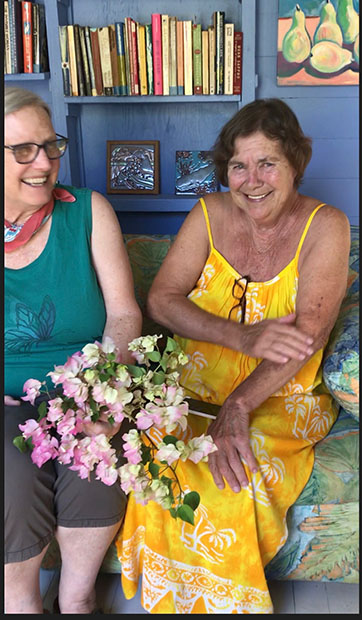
BN: That’s right, yes. My mother’s mother was a devout Catholic. Do I just think this or have I been told this? Some things my older sister knew that I didn’t know, and this might have been one of them, that my grandmother was a devout Catholic. When my mother married a Jew, she made my mother promise to bring the children up in the Catholic Church. I’m pretty sure that that grandmother paid for our education, which was always in parochial schools.
RN: Oh! All those schools you went to were all Catholic schools, or—
BN: Catholic schools, that’s right.
RN: Oh gosh, wow. No wonder you didn’t go to college. I mean, you would have had to go to a Catholic college! I bet we can go down some interesting pathways, and maybe we will; maybe I’ll do another interview. You may be the person I’ve interviewed the most! (Laughter)
See also:
Finding Women’s Lands and Lesbian Communities
Martha Ingalls and Bonnie Netherton, “Mermaid Inn, Lesbian Oasis on Fort Lauderdale Beach,” Sinister Wisdom 109 (Summer 2018): 73-76.
Red Dyke Theatre with Mickey Alberts and Frances Pici
This interview combines parts of three separate interviews. It has been edited for archiving by the interviewer and interviewee, close to the time of the interview. More recently, it has been edited and updated for posting on this website. Original interviews are archived at the Sallie Bingham Center for Women’s History and Culture in the David M. Rubenstein Rare Book and Manuscript Library at Duke University in Durham, North Carolina.
